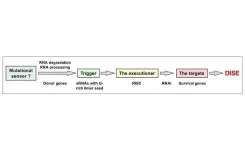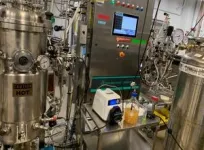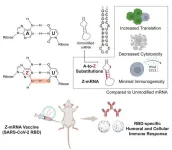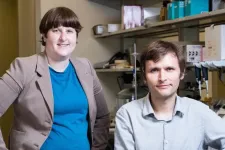(Press-News.org)
“DISE is effective against all cancers we tested.”
A new editorial paper was published in Oncotarget's Volume 14 on September 25, 2023, entitled, “DISE, an ancient anti-cancer mechanism that senses mutational load in cancerous cells?”
In their new editorial, researchers Monal Patel and Marcus E. Peter from Northwestern University discuss a recent breakthrough in cancer therapy. Despite the multiple advances in therapy, cancer remains one of the most common causes of death globally. It is a systemic disease affecting people of all ages and originates at the level of single cells which, upon acquisition of mutations, become neo-plastically transformed.
Cell division is the biggest risk factor for the accumulation of mutations, explaining why all multicellular organisms which evolved about 2 billion years ago, are prone to cancer. Given the recent achievements in cancer treatment with immune checkpoint blockade therapies, multicellular organisms may have developed the immune system as a mechanism to eradicate cancerous cells.
“However, the immune system arose relatively recent, ~500 million years ago [3].”
Moreover, studies have shown that cancer cells can become resistant to the anticancer activity of both the innate and the adaptive immune system. Therefore, while the immune system is important, it is likely not the most vital machinery that emerged in multicellular organisms to prevent cancer formation. The researchers believe that there are other more effective and archaic anti-cancer mechanisms that are conserved during evolution.
Of note, RNA interference (RNAi) is a highly conserved biological mechanism for silencing gene expression. While RNAi likely emerged as a defense tool against viruses and other foreign nucleic acids, it has also evolved to have other activities in the cells. The team’s research has identified a new evolutionarily conserved RNAi-based form of cell death that targets essential survival genes: Death Induced by Survival gene Elimination (DISE).
“DISE was discovered through our work on CD95 and its ligand, CD95L, where we found that more than 80% of 26 different short interfering RNAs (siRNAs) and short hairpin RNAs (shRNAs) derived from the two genes, killed multiple cancer cell lines via simultaneous activation of multiple cell death pathways; and we were unable to find a way to inhibit this form of cell death [9].”
Read the full paper: DOI: https://doi.org/10.18632/oncotarget.28466
Correspondence to: Marcus E. Peter
Email: m-peter@northwestern.edu
Keywords: cancer, cell death, evolution, RNAi, short RNAs
About Oncotarget: Oncotarget (a primarily oncology-focused, peer-reviewed, open access journal) aims to maximize research impact through insightful peer-review; eliminate borders between specialties by linking different fields of oncology, cancer research and biomedical sciences; and foster application of basic and clinical science.
To learn more about Oncotarget, visit Oncotarget.com and connect with us on social media:
X, formerly known as Twitter
Facebook
YouTube
Instagram
LinkedIn
Pinterest
LabTube
Soundcloud
Sign up for free Altmetric alerts about this article: https://oncotarget.altmetric.com/details/email_updates?id=10.18632%2Foncotarget.28466
Click here to subscribe to Oncotarget publication updates.
For media inquiries, please contact: media@impactjournals.com.
Oncotarget Journal Office
6666 East Quaker Str., Suite 1A
Orchard Park, NY 14127
Phone: 1-800-922-0957 (option 2)
###
END
A multi-institutional project led by a Penn State researcher is focused on developing an all-in-one semiconductor device that can both store data and perform computations. The project recently received $2 million in funding over three years as part of the new National Science Foundation Future of Semiconductors (FuSe) program, a $45.6 million investment to advance semiconductor technologies and manufacturing through 24 research and education projects across the United States.
“The goal of ...
Nemours Children’s Health will host the first-ever dedicated pediatric session at HLTH, the leading platform bringing together the entire health ecosystem focused on health innovation and transformation. This invited program, “Elevating Kids Health Well Beyond Medicine,” will extend HLTH’s 2023 theme, “Elevating Humanity,” to focus on health in childhood and why it is the only way to build good health across the lifespan.
“The child health perspective is an essential viewpoint for the attendees of HLTH to consider and we are proud to offer ...
University of Oklahoma engineering researcher Reza Foudazi, Ph.D., has been selected to receive a $600,000 grant from the U.S. Department of Defense under the Defense Established Program to Stimulate Competitive Research, or DEPSCoR. The highly competitive grant was awarded to only 28 academic teams nationwide.
An associate professor in the School of Sustainable Chemical, Biological and Materials Engineering, Foudazi’s research centers on the exploration of electrochemical energy storage systems that incorporate multivalent ions. ...
Messenger RNA (mRNA) technology has become popular in the last few years due to its use in COVID-19 vaccines. This technology has been so groundbreaking that it recently won the 2023 Nobel Prize in medicine “for discoveries concerning nucleoside base modifications that enabled the development of effective mRNA vaccines against COVID-19.” This isn’t new technology, however— modified mRNAs have been studied for decades and show significant potential for therapeutic applications. Compared to unmodified mRNAs, modified ...
Abdolhossein Haji-Sheikh, a retired professor in the Mechanical and Aerospace Engineering Department at The University of Texas at Arlington, has made a $500,000 gift to support his former department.
The gift creates an endowed professorship in heat transfer, one of Haji-Sheikh’s areas of expertise during his decades of teaching at UTA. The professorship will be awarded in 2026.
Haji-Sheikh began his career at what was then Arlington State College in 1966. He said he wants to give back to ...
Inventor of xenobots unveils new advance toward artificial life
New AI algorithm compresses billions of years of evolution into seconds
The evolved robot has three legs and rear fins, something a human engineer would never devise
Researcher: ‘Now anyone can watch evolution in action as AI generates better and better robot bodies in real time.’
A team led by Northwestern University researchers has developed the first artificial intelligence (AI) to date that can intelligently design robots from ...
Two Rice University bioengineers received the National Institutes of Health (NIH) Director’s New Innovator Award (NIA) for creative research projects demonstrating broad impact potential.
Part of the High-Risk, High-Reward Research program, NIA awards support early-career investigators with ambitious, unconventional project proposals “in any area of biomedical, behavioral or social science research relevant to the NIH mission,” according to the agency’s website.
Rice’s ...
Cancer-related fatigue (CRF) is a debilitating yet all-too-common condition, which can severely affect quality of life for patients undergoing treatment. For those struggling with CRF, there have been no effective pharmaceutical treatments for the constellation of symptoms that together define the syndrome.
In a new study led by Yale Cancer Center researchers at Yale School of Medicine, the team found that a metabolism-targeting drug called dichloroacetate (DCA) helped alleviate CRF in mice, without interfering with cancer ...
Effective September 26, 2023, NRG Oncology-RTOG 1308, a phase III randomized trial comparing overall survival after photon versus proton chemoradiotherapy for patients with inoperable stage II-IIIB non-small cell lung cancer (NSCLC) has met its accrual target. The trial, one of several NRG Oncology ongoing clinical trials across various malignancies within the National Clinical Trials Network (NCTN) that compare photon versus proton radiation therapy techniques, is the first phase III head-to-head comparison of these ...
Even as the world slowly begins to decarbonize industrial processes, achieving lower concentrations of atmospheric carbon requires technologies that remove existing carbon dioxide from the atmosphere — rather than just prevent the creation of it.
Typical carbon capture catches CO2 directly from the source of a carbon-intensive process. Ambient carbon capture, or “direct air capture” (DAC) on the other hand, can take carbon out of typical environmental conditions and serves as one weapon in the battle against climate change, particularly as reliance ...








